800,000 visitors in 2019. 40% are foreign tourists. The National Museum of the History of Ukraine in the Second World War is indeed one of the most popular tourist sites in Kyiv.
Many visitors come here to view the Motherland Monument, which is one of the ten highest monuments in the world.
In 1973, the Central Committee of the CPSU approved the construction of a memorial complex in Kyiv.

Sinking only one millimetre in 39 years
If modern civilization suddenly disappears and a new one arises, future generations will probably wonder and ask:“How could people living at the end of the 20th century build such a magnificent monument on the banks of the Dnipro?”According to the Director of the museum, Ivan Kovalchuk, all the specialists and scientists who were involved in the design and construction of the Motherland Monument were ahead of their time. Construction work began in 1976, and in 1981, Soviet General Secretary Leonid Brezhnev, whose health was already failing, arrived in the capital of the Ukrainian SSR for the grand opening of the memorial complex. During his visit, a year and a half before his death, Brezhnev dictated his message in the Book of Honoured Guests and signed his name below:
“It is with great excitement and profound emotions that I have explored the wonderful memorial complex erected in Kyiv... Many thanks to the brilliant creators! May it stand as an eternal monument to commemorate our Great Victory!”


“In order to build such a colossal structure, make correct plans and calculations, you had to be a topnotch specialist in your field. These men had to solve the most complicated engineering and logistics problems… without modern computers and technology. During the construction period, some mechanisms were used for the first time. The Motherland “sculpture” was the first large-scale all-welded metal structure in the world.” explains Ivan Kovalchuk.The Motherland statue was assembled over an internal metal frame; the stainless steel sections were welded together by specialists from the Ye.O. Paton Electric Welding Institute.
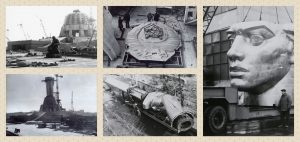
“Every year, we conduct geodetic surveys according to the regulations developed by the specialists who designed the monument. There have been no deviations from the norm. After 39 years, the monument has sunk by only one millimetre.” says Ivan Kovalchuk.In addition to geodetic control, the museum’s technical department checks all joints, blocks and structural elements several times a year… as well as everything that is hidden from prying eyes deep underground.
17.8 metres below ground level. Restricted premises
Tourists usually want to visit the Motherland’s two observation decks to get a fantastic bird’s-eye view of the capital of Ukraine. But, few people know that there is a huge underground foundation chamber which supports the massive 500-ton structure.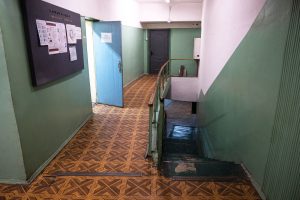




First platform. An inclined elevator and a 360-degree view
Since its inauguration in 1981, the Motherland Monument has become the most prominent landmark in Kyiv. The sculpture has been given many popular nicknames: “Halia” (according to legend, the prototype for the Motherland was Ukrainian sculptor Halyna Kalchenko), “Lavrentievna” (due to proximity to the Kyiv Pechersk Lavra), “Halyna Leonidivna” (in honour of Brezhnev’s daughter), “Baba with a sword” or just plain “Baba”. During the soviet era, up to one million people per year visited the National Museum of the History of Ukraine in the Second World War. The current figures are no less amazing – 800,000 visitors in 2019. In 39 years, a total of about 30 million persons have visited the memorial complex. Today, the war exhibits have been replenished with stories, photos and items from the ongoing Russian-Ukrainian war in the Donbas.




Second platform. Extreme sensations
Determined visitors do not stop at 36.6 metres. Adults are allowed to climb to greater heights (91 metres!), but it will cost them 300 UAH per person. Corpulent individuals are not allowed to venture up the ladders. Nothing personal, but the last stage of the vertical climb takes place in a very small space where one can get stuck.

“I tell foreign visitors that it’s the latest Apple model.” jokes Kostiantyn Lebed.The elevator rises slowly and stops at a height of 64 metres. Kostiantyn informs us that we are now at the level of the Motherland’s waistline. We start climbing several flights of stairs and arrive at the level of the Motherland’s bosom.
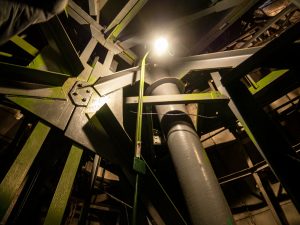
“I guess it’s some kind of built-in instinct of self-preservation.” says Lebed as he hooks a swivel carabiner and rescue rope in his belt.

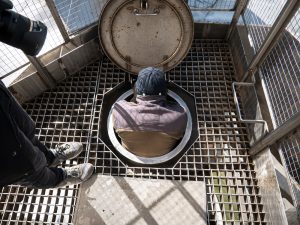
“A lot of foreigners come up here. Polish tourists are very likely to say something like “Курва!” (No shit!), while English visitors will exclaim “Wow, what the hell!” says Lebed.Inside the sword, there is a special device to dampen vibrations. The inside of the sword can also be accessed, but only by museum technicians.
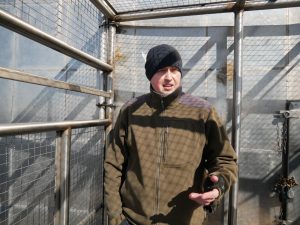
State emblem of the USSR: pull it down or leave it standing?
According to the Soviet designers, architects and builders, the Motherland can withstand an earthquake with a magnitude of 9 points on the Richter scale. The creators of the sculpture guaranteed that it would stand until 2130.










